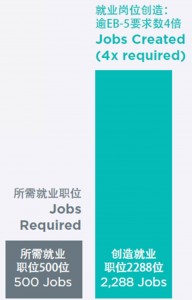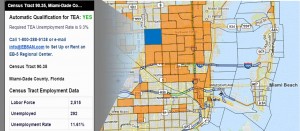EB-5 Regional Center Project – Immigration Risk Due Diligence
EB5AN is a national leader in EB-5 regional center and project consulting, with 14 regional centers that cover more than 20 states. Our team has reviewed hundreds of EB-5 projects across the country and has assembled the immigration risk due diligence framework below based on that experience.
For a foreign investor considering an investment in an EB-5 regional center sponsored project, two main types of risk must be evaluated:
- Immigration risk to get the permanent green card, and
- Financial risk to get their $900,000 or $1,800,000 investment back at the end of the investment term, or to get the initial capital contribution back along with any administrative fees as soon as possible in the case of an I-526 denial.
This article focuses on evaluating the immigration risk of EB-5 regional center investments. To learn more about the evaluation of EB-5 project financial risks, please refer to EB-5 Project Financial Risk Due Diligence.
EB-5 Project Immigration Risk Due Diligence
-
Is there a contingency plan in the event that not all desired EB-5 capital is successfully sourced? This is the single most important question when evaluating immigration risk.
From an immigration perspective, the safest projects are those that will still be completed in the event of an EB-5 shortfall. This can be in the form of an initial bridge loan or through having additional equity/other debt sources as a fallback option. This sounds counterintuitive, but the reality is that the single most important project question for an EB-5 investor (and the best way to minimize immigration risk) is to know whether or not the project can be completed without the full amount of EB-5 capital.
The safest projects from an immigration perspective are those that can be successfully constructed and operated even in the event of an EB-5 shortfall.
Ultimately, only two immigration questions matter when evaluating a potential EB-5 project:
Will the project be completed?
Factors that actually matter in this context are that the
- developer cash is irrevocably committed,
- senior loan has been executed with a major bank,
- construction completion guarantee has been executed from the parent entity, and
- project is well under construction.
Will the required number of jobs be created when the project is completed?
Factors that actually matter in this context are
- the number of jobs created from construction alone,
- the size of the job cushion created by construction alone, and
- the amount of total construction cost spent to date when EB-5 investor capital enters the project.
If the answer to the two questions above is a clear yes, then the investor’s immigration risk in the EB-5 project has effectively been minimized.
How does an investor find a project that yields “yes” answers to those two questions? Let’s break down each of the questions and determine what has to be true for each to be considered a clear “yes.”
Will the project actually be completed?
At the root of this question is whether the project actually gets built as described and projected in the EB-5 compliant business plan. This means that the projected amount of capital for construction is spent, that no major time delays occur during construction, and that the project experiences no cost shortfalls or overruns.
If a project has identified options for the full capitalization and has alternatives (even if vastly more expensive) to EB-5 funding, then the immigration risk of the project not being completed has been minimized.
For example, consider a $100 million hotel project in which the developer has committed to invest $30 million of cash equity and has taken a senior bank loan for the remaining $70 million. For this scenario, assume that the senior loan can only be executed once $30 million of total developer equity plus EB-5 funding has been committed to the project. If the developer was seeking to raise $15 million of EB-5 funding and have $15 million of equity in the project, then the sponsor could execute the senior loan when $30 million in cash is available. The developer could either (i) wait for the EB-5 funding, (ii) use a bridge loan for $15 million, or (iii) use bridge equity that is anticipated to be recapped out once EB-5 funding is identified.
If the developer has plans to move forward in all three of the above scenarios, regardless of how many EB-5 investors enter the project (one investor or the maximum 17 investors needed to reach $15 million) the project has sufficient capital for completion, and so success is not determined by how much EB-5 capital (or how many EB-5 investors) is found for the project. If the project moved forward without the full amount of EB-5 funding, it could significantly hamper the developer from completing their next project if they have to over-commit on the anticipated equity, but from an immigration perspective, at least the project will still be completed.
This issue is vitally important, since the EB-5 market today is quite competitive and few projects achieve full subscription quickly (i.e., find the target number of EB-5 investors within the expected fundraise time frame).
Will the required number of jobs be created when the project is completed?
The key to this question is job creation. Many projects determine job creation as a combination of both construction expenditures and operational revenues. The safest projects are those in which the job creation from construction expenditures alone creates several times the required number of jobs per investor. To reduce the immigration risk even further, investors should seek projects that are already well under construction, with very high job cushions.
Consider again the $100 million hotel project example above. Let’s say that this project creates a total of 1,200 EB-5 compliant jobs, and of these jobs, 1,000 are attributable to construction expenditures and 200 to operating revenues (once the hotel is open). Now, if the hotel costs $100 million, that means that once $50 million is spent on construction, roughly 50% of the jobs have been created; in this case, 500 jobs. Since the project has no more than 17 EB-5 investors, and it must create 10 jobs per EB-5 investor, the project needs to create only 170 jobs. The project creates 1,000 jobs from construction alone, which means the project has a 588% job cushion. This level of job cushion is very attractive for EB-5 investors, since it means the project has a much lower immigration risk.
If an EB-5 investor invested in this project halfway through the construction period, essentially all of the EB-5 investor’s immigration risk is eliminated. Why is this the case? Once the project is 50% complete, approximately $50 million has been spent on construction expenditures, and therefore roughly 500 of the 1,000 jobs have already been created. Since only 170 jobs are required for 17 EB-5 investors to get their green cards, this means the project still has a 294% job cushion even if it stopped construction and was never completed after the EB-5 investors entered the project at the halfway point.
Let’s say, for example, that all 17 EB-5 investors did invest the combined $15 million in EB-5 capital into the hotel project when the project was halfway through the construction period. Then, the following week, an earthquake hit the local area and the entire hotel site was swallowed up by a sinkhole and the land became unusable as a result. In this case, all 17 EB-5 investors would still get their I-526 and I-829 petitions approved since the project did create the 10 required jobs per investors, despite the fact that the project was not successfully completed. As long as the job requirement is met, the project does not have to be successfully completed for EB-5 investors to get their I-526 and I-829 petitions approved.
The safest possible EB-5 project from an immigration perspective is one where the required EB-5 job creation for all EB-5 investors in the project has already occurred when the first EB-5 investor enters the project.
This type of project is not uncommon in the market today, and EB-5 investors should ask all of the questions above to determine whether a project truly meets these criteria.
The bad news — EB-5 investors beware

Almost every EB-5 project agent will tell potential EB-5 investors that the project being sold will happen regardless of how many EB-5 investors come into the project and that any amount of job cushion makes a project safe. The reality, however, is that the devil is in the details: most of these projects are misleading investors with exceptions built into their project documents that either allow other types of financing to come in senior to EB-5 capital if there is a shortfall or that allow the EB-5 loan to be cancelled if a certain capital threshold is not met.
Other common terms include escrow release provisions that require a certain amount of capital prior to release of funds. In such cases, if the target capital raise is never reached, then the EB-5 investors who did invest face multiple years of delays and potential capital loss. The reality is that many of these “shortfall commitments” are not actually enforceable from third-party lenders, and many project developers do not want to commit to take in EB-5 capital unless it is for a certain amount within a certain timeframe.
Investors should always conduct detailed due diligence on the EB-5 projects presented to them and use this framework as a starting point to screen out and avoid higher risk EB-5 projects.
-
Does the project include any job cushion (construction jobs only)?
For every single EB-5 investor, at least 10 jobs (indirect, direct, and induced) must be created by the project. The larger the job cushion, the safer the project. Projects are especially safe when the required 10 jobs can be met from construction expenditures alone and do not require any operational jobs. Many projects on the market today have a job cushion of at least 20%, but investors looking to minimize immigration risk should target a job cushion of 100% or more.

-
When will the EB-5 job creation occur?
USCIS regulations require that the job creation of a project occur after the EB-5 investment has been made into the project and within 2.5 years following approval of the investor’s I-526 Petition. If the project does not create the required number of jobs within the allotted time period, EB-5 investors will be at risk of losing their conditional permanent resident status at the I-829 stage of the EB-5 process.
USCIS has issued a policy memorandum that states that bridge financing (equity or debt) in the project prior to the entrance of EB-5 capital can be applied toward the total job creation calculation of the project. This means that even though a project started construction before EB-5 capital was invested, all the construction expenditures and resulting jobs from the beginning of construction can be counted toward the EB-5 requirement of 10 jobs per investor.
-
Has the project been preapproved by USCIS (I-924 project exemplar)?
Investors filing I-526 petitions should ask whether the project has been preapproved by USCIS as a project exemplar. However, since the processing time for a project exemplar can be 12–16 months, this application is often still pending with USCIS when investors file their I-526 Petitions. Since filing a project exemplar is not required (even though it is a best practice), investors should confirm with the project sponsor that a project exemplar application has been submitted to USCIS and that a receipt notice can be provided as evidence. If a project is a USCIS-approved exemplar or an individual I-526 has been approved by USCIS, the project has successfully met the USCIS standards for the EB-5 program, and any future investors and I-526 petitions should be approved (usually at an expedited rate).
-
Is the project located in an officially designated targeted employment area (TEA)?
Answering this question is critical for determining whether the EB-5 investment will qualify as a $900,000 investment instead of requiring the standard $1,800,000. Targeted employment area (TEA) designation must be issued by USCIS at the time of the I-526 or I-924 project exemplar submission(s) to USCIS.
-
Does the project have an EB-5/Matter of Ho–compliant business plan?
One of the most basic EB-5 requirements is that the business plan must be Matter of Ho compliant. The primary consideration here is whether the business plan meets the requirements of the EB-5 Immigrant Investor Program in terms of job creation, the amount of EB-5 capital, and the key assumptions made for the successful development and operation of the business in question.











